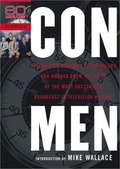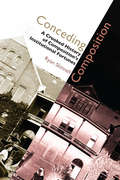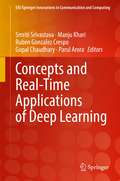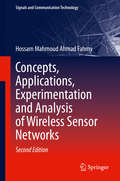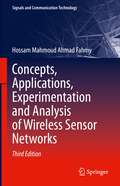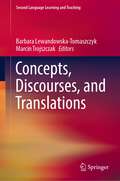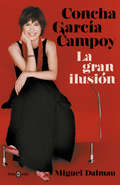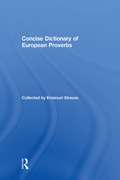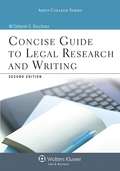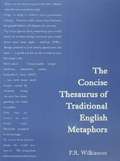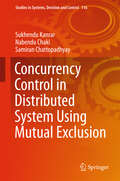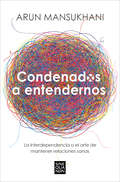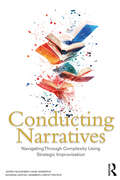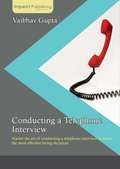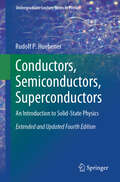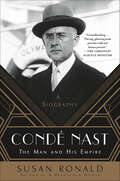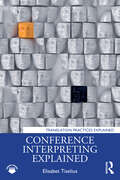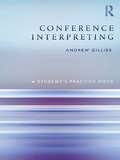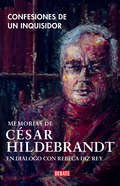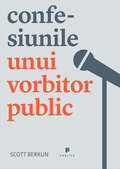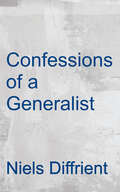- Table View
- List View
Con Men: Fascinating Profiles of Swindlers and Rogues from the Files of the Most Successful Broadcast in Television History
by Ian Jackman60 Minutes brings its award-winning journalistic skills and unmistakable broadcast style to the page, delving into its archives to present stories on one of the program's most popular subjects: the con man. Con Men exposes a truly eclectic group of swindlers and rogues: the extraordinary characters of ABSCAM, pyramid-scheme millionaires and stock-market crooks, snake-oil salesmen and art forgers. Many of them are diabolical -- all of them are intriguing. Here 60 Minutes captures each one in vivid det...
Conceding Composition: A Crooked History of Composition's Institutional Fortunes
by Ryan SkinnellFirst-year composition became the most common course in American higher education not because it could “fix” underprepared student writers, but because it has historically served significant institutional interests. That is, it can be “conceded” in multiple ways to help institutions solve political, promotional, and financial problems. Conceding Composition is a wide-ranging historical examination of composition’s evolving institutional value in American higher education over the course of nearly a century. Based on extensive archival research conducted at six American universities and using the specific cases of institutional mission, regional accreditation, and federal funding, this study demonstrates that administrators and faculty have introduced, reformed, maintained, threatened, or eliminated composition as part of negotiations related to nondisciplinary institutional exigencies. Viewing composition from this perspective, author Ryan Skinnell raises new questions about why composition exists in the university, how it exists, and how teachers and scholars might productively reconceive first-year composition in light of its institutional functions. The book considers the rhetorical, political, organizational, institutional, and promotional options conceding composition opened up for institutions of higher education and considers what the first-year course and the discipline might look like with composition’s transience reimagined not as a barrier but as a consummate institutional value.
Concepts and Real-Time Applications of Deep Learning (EAI/Springer Innovations in Communication and Computing)
by Smriti Srivastava Manju Khari Gopal Chaudhary Ruben Gonzalez Crespo Parul AroraThis book provides readers with a comprehensive and recent exposition in deep learning and its multidisciplinary applications, with a concentration on advances of deep learning architectures. The book discusses various artificial intelligence (AI) techniques based on deep learning architecture with applications in natural language processing, semantic knowledge, forecasting and many more. The authors shed light on various applications that can benefit from the use of deep learning in pattern recognition, person re-identification in surveillance videos, action recognition in videos, image and video captioning. The book also highlights how deep learning concepts can be interwoven with more modern concepts to yield applications in multidisciplinary fields.Presents a comprehensive look at deep learning and its multidisciplinary applications, concentrating on advances of deep learning architectures;Includes a survey of deep learning problems and solutions, identifying the main open issues, innovations and latest technologies;Shows industrial deep learning in practice with examples/cases, efforts, challenges, and strategic approaches.
Concepts, Applications, Experimentation and Analysis of Wireless Sensor Networks (Signals and Communication Technology)
by Hossam Mahmoud FahmyThe new edition of this popular book has been transformed into a hands-on textbook, focusing on the principles of wireless sensor networks (WSNs), their applications, their protocols and standards, and their analysis and test tools; a meticulous care has been accorded to the definitions and terminology. To make WSNs felt and seen, the adopted technologies as well as their manufacturers are presented in detail. In introductory computer networking books, chapters sequencing follows the bottom up or top down architecture of the seven layers protocol. This book starts some steps later, with chapters ordered based on a topic’s significance to the elaboration of wireless sensor networks (WSNs) concepts and issues. With such a depth, this book is intended for a wide audience, it is meant to be a helper and motivator, for both the senior undergraduates, postgraduates, researchers, and practitioners; concepts and WSNs related applications are laid out, research and practical issues are backed by appropriate literature, and new trends are put under focus. For senior undergraduate students, it familiarizes readers with conceptual foundations, applications, and practical project implementations. For graduate students and researchers, transport layer protocols and cross-layering protocols are presented and testbeds and simulators provide a must follow emphasis on the analysis methods and tools for WSNs. For practitioners, besides applications and deployment, the manufacturers and components of WSNs at several platforms and testbeds are fully explored.
Concepts, Applications, Experimentation and Analysis of Wireless Sensor Networks (Signals and Communication Technology)
by Hossam Mahmoud FahmyThe third edition of this hands-on textbook pursues the focus on the principles of wireless sensor networks (WSNs), their applications, their protocols and standards, and their analysis and test tools; a meticulous care has been accorded to the definitions and terminology. To make WSNs felt and seen, the adopted technologies as well as their manufacturers are presented in detail. In introductory computer networking books, chapters sequencing follows the bottom up or top down architecture of the seven layers protocol. This book is some more steps after, both horizontally and vertically, the view and understanding are getting clearer, chapters ordering is based on topics significance to the elaboration of wireless sensor networks (WSNs) concepts and issues.This book is intended for a wide audience, it is meant to be help and motivate, for both the senior undergraduates, postgraduates, researchers, and practitioners; concepts and WSNs related applications are laid out, research and practical issues are backed by appropriate literature, and new trends are put under focus. For senior undergraduate students, it familiarizes with conceptual foundations, applications and practical projects implementations. For graduate students and researchers, energy-efficient routing protocols, transport layer protocols and cross-layering protocols approach are presented. Testbeds and simulators provide a must follow emphasis on the analysis methods and tools for WSNs. For practitioners, besides applications and deployment, the manufacturers and components of WSNs at several platforms and testbeds are fully explored.
Concepts, Discourses, and Translations (Second Language Learning and Teaching)
by Barbara Lewandowska-Tomaszczyk Marcin TrojszczakThis present book discusses issues related to languages, cultures, and discourses by addressing a variety of topics ranging from culture and translation, cognitive and linguistic dimensions of discourse, and the role of language in political discourses and bilingualism. By focusing on multiple interconnected research subjects, the book allows us to see the intersections of language, culture, and discourse in their full diversity and to illuminate their less frequented nooks and crannies in a timely fashion.
Conceptual Digital Signal Processing with MATLAB (Signals and Communication Technology #20)
by Keonwook KimThis textbook provides an introduction to the study of digital signal processing, employing a top-to-bottom structure to motivate the reader, a graphical approach to the solution of the signal processing mathematics, and extensive use of MATLAB.In contrast to the conventional teaching approach, the book offers a top-down approach which first introduces students to digital filter design, provoking questions about the mathematical tools required. The following chapters provide answers to these questions, introducing signals in the discrete domain, Fourier analysis, filters in the time domain and the Z-transform. The author introduces the mathematics in a conceptual manner with figures to illustrate the physical meaning of the equations involved. Chapter six builds on these concepts and discusses advanced filter design, and chapter seven discusses matters of practical implementation. This book introduces the corresponding MATLAB functions and programs in every chapter with examples, and the final chapter introduces the actual real-time filter from MATLAB.Aimed primarily at undergraduate students in electrical and electronic engineering, this book enables the reader to implement a digital filter using MATLAB.Deliver the conceptual knowledge of digital signal processing with extensive use of the illustrations from practical viewpoint. Also, the digital signal processing is initiated from the digital not from the continuous domain.
Concha García Campoy: La gran ilusión
by Miguel DalmauCon motivo del quinto aniversario de la muerte de una de las periodistas más queridas de nuestro país, esta biografía autorizada es un apasionante y muy entretenido relato de su vida. A los cinco años de su muerte, la figura de Concha García Campoy sigue viva en el recuerdo de todos nosotros. Desde su aparición en los Informativos de TVE a mediados de los años ochenta, procedente de su querida Ibiza, hasta su último programa en un magacín, la periodista se mantuvo en la cumbre durante tres décadas, desarrollando una carrera excepcional caracterizada por el máximo rigor, la cercanía con el público y la independencia. Pero tras esa trayectoria coronada por el éxito, había una mujer de origen humilde cuya infancia estuvo marcada por la tragedia. Este libro, escrito por uno de los biógrafos más solventes del país, cuenta la apasionante historia de una mujer de nuestro tiempo -amable, generosa, sencilla, divertida-, y aborda libremente aspectos íntimos muy poco conocidos de su vida amorosa y profesional. Para ello ha contado con el valioso testimonio de su familia; de sus parejas; de sus grandes amigas, Ángeles Caso, María Escario, Elena Sánchez y Olga Viza, entre otras, así como compañeras de trabajo y personas de su entorno, donde aparecen figuras tan dispares como Alfonso Guerra, Mariano Rajoy, Juan Cruz, Iñaki Gabilondo, Luis del Olmo, Manuel Campo Vidal, Fernando Delgado, David Trueba, Santiago Segura o Pilar Eyre. Todas ellas se dan cita en esta biografía, que cautiva al instante al lector, porque nos devuelve con toda su luz a una mujer que dedicó gran parte del tiempo a vivir con gozo y a transmitir esa alegría a los demás. El libro incluye también fragmentos del Diario personal de la periodista donde se sincera a corazón abierto hablando de sus sentimientos más profundos y de su heroica lucha contra el cáncer. Al final la enseñanza que Concha García Campoy nos transmite es inolvidable: «Es bueno sentir, sufrir, querer, reaccionar a lo que te da la vida. Eso es estar vivo». Sus amigos hablan de ella...«Era una matriarca. Le encantaba proteger. No dejaba a nadie tirado. Siempre estaba pendiente de todo el mundo.» Ángeles Caso «Su atractivo es de naturaleza estival, y tiene un componente mediterráneo muy acusado. [...] Ella nos mira y se comporta como si viviera en otro mundo, más feliz y risueño.»Juan Marsé «Ella tenía una virtud como periodista que a mi juicio resaltaba sobre todo lo demás: era una persona que escuchaba a quien estaba entrevistando, le oía, y sus preguntas venían precisamente porque te estaba escuchando.»Alfonso Guerra «La aportación de Concha fue extraordinaria porque hizo una radio en tecnicolor. Me refiero al tecnicolor de la nueva sociedad española.»Iñaki Gabilondo «No hacía distinción de clases sino todo lo contrario. Venía de abajo y le gustaba sentirse de abajo, aunque circulaba por arriba.»Manuel Campo Vidal «A lo largo de su vida Concha mantuvo una independencia total, sin veleidades ni concesiones.»Luis Del Olmo «Tenía la cabeza sobre los hombros. No hacía nada que pudiera romper la estabilidad de los otros.»Olga Viza «Merece la pena escribir una novela para que te entreviste Concha García Campoy.»Javier Tomeo «Yo creo que Concha sintió enseguida que Andrés Vicente Gómez sacaba lo mejor de ella, y él sintió que ella sacaba lo mejor de él. Ésa fue una de las claves de su gran historia de amor.»Luis Alegre «Era la mejor anfitriona que he visto nunca, pero no sólo con nosotros sino con mucha gente.»Santiago Segura «Concha era nuestra novia soñada.»David Trueba
Concise Dictionary of European Proverbs
by Emanuel StraussThis concise edition of the definitive 3-volume Dictionary of European Proverbs constitutes a fascinating collection of proverbs in 29 languages. The entries are arranged alphabetically according to the English equivalent, allowing the reader to identify common trends easily and quickly. * All proverbs listed in original language * 29 European languages featured * Includes all proverbs in current use * Thoroughly checked by language specialists to ensure accuracy. The Concise Dictionary of European Proverbs is based on over 40 years in-depth research by the compiler. It is an essential reference source for linguists, ethnologists and folklorists, and of interest to anyone wanting to know about the origins, development and current usage of the proverb. Emanuel Straussis a world-renowned expert on proverbs.
Concise Guide To Legal Research And Writing
by Deborah E. BouchouxA clear, well-organized text for the introductory legal research and writing course, designed specifically for paralegal students, Concise Guide to Legal Research and Writing Second Edition covers legal research and legal writing in a concise and pragmatic manner and is ideal for introductory, abbreviated, or online courses.
Concise Guide to Legal Research and Writing (Aspen Paralegal Series)
by Deborah E. BouchouxFeaturing Deborah E. Bouchoux s highly regarded assignments, examples, and building-block approach, Concise Guide to Legal Research and Writing, Fourth Edition continues to provide timely coverage of the essential research and writing skills used by today's paralegals. Designed specifically for paralegal students, this is the ideal text for shorter legal research and writing courses. <p><p> New to the Fourth Edition: <p> <p>New Sidebar feature in all research chapters provides quick tips showing how the material in that chapter applies to computer-assisted legal research systems, such as Lexis, Westlaw, and Bloomberg Law. <p>Discussion of GovInfo, which provides free public access to official and authenticated publications from all three branches of the federal government. <p>Coverage of new tools used for cite-checking, including EVA and Bestlaw. <p>Discussion of Westlaw Edge, Westlaw s new research platform. <p>Extensive new coverage of the increasing use of artificial intelligence in legal research and writing. <p>Discussion of new sources that provide free public access to the law, including Harvard's Caselaw Access Project, CourtListener, and RECAP Project. <p>New sections on preparing email letters and email memoranda, including assignments. All new Research Questions and Internet Legal Research Assignments have been included for each chapter. <p><p>Professors and students will benefit from: <p> Concise, well-organized text, divided into six main sections: <ul style="list-style-type: circle;"> <li>Section I discusses primary authorities</li> <li>Section II covers secondary sources</li> <li>Section III focuses on computer-assisted legal research using Lexis Advance, Westlaw, and the Internet</li> <li>Section IV covers citation form and how to ensure that these sources are still good law</li> <li>Section V provides an overview of the legal research process</li> <li>Section VI covers legal writing</li> </ul> <p>Pedagogy designed to enhance the accessibility of the material, including helpful charts and diagrams that synthesize complex topics, updated Practice Tips offering realistic and helpful suggestions for workplace success, and Ethics Alerts in every chapter. <p>Targeted and ample exercises help students learn how to use a wide range of research sources. <p>Tips on how to effectively use electronic resources are included throughout the text. <p>Conscientious revision ensures that the book has the most up-to-date material, presented in a readable and accessible format.
Concise Thesaurus of Traditional English Metaphors
by Dick WilkinsonThis absorbing collection of metaphors includes a variety of expressions with figurative meanings, like similes, proverbs, slang and catchphrases. It is the result of a lifetime of work on dialect and metaphor and gives an overview of the folk wisdom expressed in figurative expressions. The author draws on his extensive contact with the rural cultures of Dorset, Cornwall, Yorkshire and Lancashire, but has also included a range of sayings from North America, Australia, Scotland and other English speaking countries. With revised contents and an improved index to make individual entries easier to find, the Concise can be used to check the meaning and the origin of an expression or to avoid mixed metaphors, anachronisms and incongruities. It is a joy to browse long after your original query has been answered.
Concurrency Control in Distributed System Using Mutual Exclusion (Studies in Systems, Decision and Control #116)
by Nabendu Chaki Sukhendu Kanrar Samiran ChattopadhyayThe book presents various state-of-the-art approaches for process synchronization in a distributed environment. The range of algorithms discussed in the book starts from token based mutual exclusion algorithms that work on tree based topology. Then there are interesting solutions for more flexible logical topology like a directed graph, with or without cycle. In a completely different approach, one of the chapters presents two recent voting-based DME algorithms. All DME algorithms presented in the book aim to ensure fairness in terms of first come first serve (FCFS) order among equal priority processes. At the same time, the solutions consider the priority of the requesting processes and allocate resource for the earliest request when no such request from a higher priority process is pending.
Condenados a entendernos: La interdependencia o el arte de mantener relaciones sanas
by Arun MansukhaniEl arte de mantener relaciones sanas, por el psicólogo referente en España en relaciones interpersonales. «La disyuntiva no es depender o no depender. La disyuntiva es si podemos depender o no de forma sana». El ser humano es un animal social. Todos nosotros, desde nuestra perspectiva única, necesitamos el contacto con otras personas. Necesitamos relacionarnos. Aun así, es muy habitual sufrir la toxicidad, la dependencia malsana o el apego excesivo tanto en pareja como con amigos y círculos laborales. Necesitamos relacionarnos, pero a menudo no sabemos cómo y eso acaba creando sufrimiento. En este libro, el terapeuta referente de la psicología interpersonal Arun Mansukhani nos acerca a la naturaleza social que hay en todos nosotros y nos da las claves para entender por qué estar con otros es tan importante para nuestro desarrollo personal. Porque todos, a lo largo de nuestra vida, hemos ido aprendiendo de forma inconsciente un patrón de comportamiento y unas estrategias relacionales. Pero si se aprendieron, se pueden corregir para adquirir nuevos patrones que nos permitan relacionarnos de una forma distinta. Y es que, a menudo, estar bien con los demás depende también de nosotros.
Conducting Narratives: Navigating Through Complexity Using Strategic Improvisation
by Jesper Falkheimer Hans Gennerud Katarina Gentzel Sandberg Mats TyrstrupHow can the strategic direction for an organization be supported and communicated if planning, and even strategies, are no longer sufficient options in the age of complexity? In this book it is argued that sense-making communication defines contemporary societies and organizations in a world where narratives and the ability to engage in strategic improvisation are crucial. In the book, new and old ideas about communication and management are integrated into a framework rooted in the humanities and fine arts. The result is a new conceptual mindset for management which claims that jazz music, narrative theory, and improvisational theatre have more to offer to the development of organizations than traditional managerial models.
Conducting a Telephone Interview
by Vaibhav GuptaThis book is designed for managers and HR professionals who have to conduct telephone interviews and wish to improve their technique in order to get the most out of the recruitment process.
Conductors, Semiconductors, Superconductors: An Introduction to Solid-State Physics (Undergraduate Lecture Notes in Physics)
by Rudolf P. HuebenerThis compact undergraduate textbook provides a concise yet thorough introduction to the fundamentals of solid-state physics, while also briefly discussing the historical context surrounding key scholars in the field. The vivid explanations and unique didactic approach adopted in the book aim to generate interest in these subjects while also serving as a motivating primer and supporting companion for studying more detailed and advanced textbooks in solid-state physics. The book is also suitable as a quick refresher for students preparing for examinations. The fourth edition features extensions in many sections. In particular, superconductivity in interfaces and monolayers and the concepts of quantum computers are subjects of new sections. Primarily concentrating on the electric and magnetic properties of materials, the book benefits undergraduate students in the fields of physics, materials science, and electrical engineering.
Condé Nast: The Man and His Empire: A Biography
by Susan RonaldThe first biography in over thirty years of Condé Nast, the pioneering publisher of Vogue and Vanity Fair and main rival to media magnate William Randolph Hearst.Condé Nast’s life and career was as high profile and glamorous as his magazines. Moving to New York in the early twentieth century with just the shirt on his back, he soon became the highest paid executive in the United States, acquiring Vogue in 1909 and Vanity Fair in 1913. Alongside his editors, Edna Woolman Chase at Vogue and Frank Crowninshield at Vanity Fair, he built the first-ever international magazine empire, introducing European modern art, style, and fashions to an American audience. Credited with creating the “café society,” Nast became a permanent fixture on the international fashion scene and a major figure in New York society. His superbly appointed apartment at 1040 Park Avenue, decorated by the legendary Elsie de Wolfe, became a gathering place for the major artistic figures of the time. Nast launched the careers of icons like Cecil Beaton, Clare Boothe Luce, Lee Miller, Dorothy Parker and Noel Coward. He left behind a legacy that endures today in media powerhouses such as Anna Wintour, Tina Brown, and Graydon Carter.Written with the cooperation of his family on both sides of the Atlantic and a dedicated team at Condé Nast Publications, critically acclaimed biographer Susan Ronald reveals the life of an extraordinary American success story.
Confederacy of Silence: A True Tale of the New Old South
by Richard RubinDiscussion of the New South by a news correspondent on a Southern paper.
Conference Interpreting Explained (Translation Practices Explained)
by Elisabet TiseliusBuilding on the foundations of Roderick Jones’ authoritative and popular text, this brand-new textbook is a comprehensive, up-to-date and easily accessible introduction to conference interpreting. Elisabet Tiselius combines practical approaches and their theoretical underpinnings to guide beginning students. The text links exercises to the theory behind them, from early theories to modern understandings of the demands of conference interpreting.This guide includes invaluable material on freelancing and professional development. Tiselius integrates remote interpreting and computer-aided interpreting throughout the book. The volume also includes a range of exercises from self-assessment, speech-writing, and note-taking to consecutive and simultaneous. Theoretical concepts are illustrated with anecdotes from Elisabet Tiselius’ personal experience, taking readers behind the scenes of conference interpreter education, and equipping them with the tools to understand how to practise and why different exercises are necessary.With further reading and related video resources here: https://routledgetranslationstudiesportal.com/, this is the essential guide to understanding the practice and theory of conference interpreting for all courses in interpreting and interpreter training.
Conference Interpreting: A Student’s Practice Book
by Andrew GilliesConference Interpreting: A Student’s Practice Book brings together a comprehensive compilation of tried and tested practical exercises which hone the sub-skills that make up successful conference interpreting Unique in its exclusively practical focus, Conference Interpreting: A Student’s Practice Book, serves as a reference for students and teachers seeking to solve specific interpreting-related difficulties. By breaking down the necessary skills and linking these to the most relevant and effective exercises students can target their areas of weakness and work more efficiently towards greater interpreting competence.<P><P> Split into four parts, this Practice Book includes a detailed introduction offering general principles for effective practice drawn from the author’s own extensive experience as an interpreter and interpreter-trainer. The second ‘language’ section covers language enhancement at this very high level, an area that standard language courses and textbooks are unable to deal with. The last two sections cover the key sub-skills needed to effectively handle the two components of conference interpreting; simultaneous and consecutive interpreting.<P> Conference Interpreting: A Student’s Practice Book is non language-specific and as such is an essential resource for all interpreting students regardless of their language combination.
Confesiones de un inquisidor: Memorias de César Hildebrandt en diálogo con Rebeca Diz Rey
by César HildebrandtCésar Hildebrandt, el periodista peruano más representativo de nuestro tiempo, rememora con detalle los episodios que construyeron su vida íntima, su carrera profesional y, más de una vez, los hitos que marcaron el destino de nuestra república. Durante 29 sesiones realizadas entre los años 2017 y 2020 junto a Rebeca Diz, César Hildebrandt, el periodista peruano más representativo de nuestro tiempo, rememora con detalle los episodios que construyeron su vida íntima, su carrera profesional y, más de una vez, los hitos que marcaron el destino de nuestra república. A lo largo de estas páginas el autor evoca sus primeros años de formación cuando era alumno del colegio Leoncio Prado; su labor como articulista y editor en diversos medios de prensa escrita; su conflictiva relación con la televisión nacional; su temporada de autoexilio en España; su lúcida lectura de la historia y la política peruanas; su infatigable pasión por la literatura, y también sus diversos desencantos, amores y supersticiones, entre otras facetas que configuran el complejo perfil de un hombre «apasionado de la razón». En Confesiones de un inquisidor, César Hildebrandt da cuenta de una existencia comprometida con el ejercicio de comunicar la verdad. Una vida contada desde la convicción de quien observa el camino recorrido sin arrepentimientos ni rencores, y que constituye, indiscutiblemente, un capítulo esencial en la historia del periodismo peruano.
Confesiones de una editora poco mentirosa
by Esther TusquetsLibro de memorias de Esther Tusquets, que complementa sus anteriores éxitos de ventas y de crítica. Sincero y audaz, donde la autora habla sin tapujos de su vida en el mundo de la edición. Esther Tusquets, la gran escritora y editora que transformó Lumen, en su origen una editorial franquista y católica, en un sello literario de referencia, escribió este libro alentada por su hija, Milena Busquets, también autora y directora del sello tiempo después: «Esto es lo que quiero que escribas. No unas memorias solemnes, sino estas pequeñas anécdotas que constituyen la vida cotidiana de una editorial y que cuando las cuentas tú resultan divertidas». Así nació este libro iluminador y emocionante, indispensable para los amantes de la literatura y de la edición, que, como no podía ser de otro modo con una mujer que «vive como editora todas las horas del día y sueña con libros la mayor parte de las noches», recoge anécdotas y retratos inolvidables de grandes escritores y agentes como Mario Vargas Llosa, Carmen Martín Gaite, Camilo José Cela, Miguel Delibes, Umberto Eco y Carmen Balcells, y los avatares de una gran aventura editorial, en la que no faltaron difi cultades y situaciones amargas, pero también ese «momento sublime para el editor: aquel en que abre el original de un perfecto desconocido y se encuentra ante una obra importante». La crítica ha dicho:«No son unas memorias solemnes, sino el ejercicio de inteligencia de una mujer que comprendió lo literario desde otro punto de vista.»Karina Sainz Borgo, VozPópuli «Una escritora proustiana que utiliza la memoria como arma de conocimiento. Un espléndido ajuste de cuentas con las costumbres de la España del último medio siglo.»Ana María Moix «Con una sinceridad fuera de lo corriente, llevó el género de la autobiografía hacia caminos desconocidos en España.»Josep Maria Castellet «Uno de los grandes testigos de la vida de la burguesía catalana en la segunda mitad del siglo XX y una de las escritoras más dotadas para la evocación en la literatura española.»El Mundo «Una mujer enormemente sensible, luchadora, crítica, gran escritora y magnífica editora. [...] Una persona que ha contribuido como muy poca gente a lo que somos nosotros mismos, este país nuestro, desde el punto de vista cultural.»Ferran Mascarell «Aparcada la vertiente de editora, renació la de escritora, pero esta vez con esa famosa sensación de ir dejando lastre que impregnaba su literatura pero que acentuaría centrándose directamente en recuerdos y en memorias.»El País «Estas Confesiones de una editora poco mentirosa de Esther Tusquets muestran una vida interesantísima y con contradicciones sobre la que ha hablado y escrito mucho, muchísimo.»The Huffington Post
Confesiunile unui vorbitor public
by Scott BerkunÎn acest volum plin de haz ?i extrem de practic, scriitorul ?i vorbitorul profesionist Scott Berkun ne dezv?luie tehnicile folosite de marii oratori ?i ne arat? cum le poate utiliza oricine pentru a comunica mai bine.
Confessions of a Generalist
by Niels DiffrientThis is not a book...it's a dynamic communication product that avoids typical book limitations. In this design, all 268 illustrations are connected directly to the text at the point of their mention with captions that extend the topics. Applying the same intensity of usability as I do with all product design, my objective was to create a reading experience much like life-engaging both the intellect and the senses.
